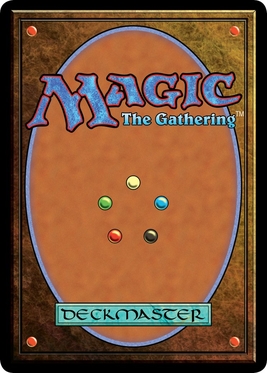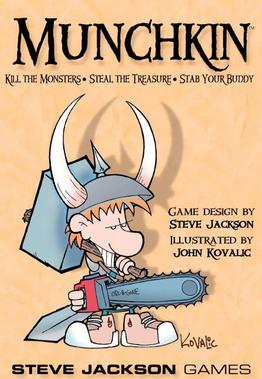Related Research Articles

Magic: The Gathering is a tabletop and digital collectible card game created by Richard Garfield. Released in 1993 by Wizards of the Coast, Magic was the first trading card game and had approximately fifty million players as of February 2023. Over twenty billion Magic cards were produced in the period from 2008 to 2016, during which time it grew in popularity. As of the 2022 fiscal year, Magic generates over $1 billion in revenue annually.

Pinochle, also called pinocle or penuchle, is a trick-taking ace–ten card game, typically for two to four players and played with a 48-card deck. It is derived from the card game bezique; players score points by trick-taking and also by forming combinations of characters into melds. It is thus considered part of a "trick-and-meld" category which also includes the game belote. Each hand is played in three phases: bidding, melds, and tricks. The standard game today is called "partnership auction pinochle".

Texas hold 'em is one of the most popular variants of the card game of poker. Two cards, known as hole cards, are dealt face down to each player, and then five community cards are dealt face up in three stages. The stages consist of a series of three cards, later an additional single card, and a final card. Each player seeks the best five-card poker hand from any combination of the seven cards: the five community cards and their two hole cards. Players have betting options to check, call, raise, or fold. Rounds of betting take place before the flop is dealt and after each subsequent deal. The player who has the best hand and has not folded by the end of all betting rounds wins all of the money bet for the hand, known as the pot. In certain situations, a "split pot" or "tie" can occur when two players have hands of equivalent value. This is also called "chop the pot". Texas hold 'em is also the H game featured in HORSE and HOSE.

The Pokémon Trading Card Game, abbreviated as PTCG or Pokémon TCG, is a collectible card game developed by Creatures Inc. based on the Pokémon franchise. Standard gameplay cards include Pokémon cards, energy cards, trainer cards, and stadium cards, a variant of trainer cards. Pokémon cards contain data about the creature's type, attacks, ability, and HP as well as any special effects the cards have on the game. Basic (unevolved) Pokémon can change into their evolved forms during the game by playing subsequent evolution cards in the deck. Energy cards can be attached to Pokémon cards to power up attacks, and trainer cards can be used for different effects on the game. Card effects often rely on elements of luck, such as dice rolls and coin tosses, to decide an outcome. Counters are stacked on top of cards in play to indicate damage dealt, and players may choose to put their Pokémon cards on a bench to switch to a different attacker.
Spite and malice, also known as cat and mouse, is a relatively modern American card game for two or more players. It is a reworking of the late 19th-century Continental game crapette, also known as Russian bank, and is a form of competitive solitaire, with a number of variations that can be played with two or three regular decks of cards.

In a deck of playing cards, the term face card (US) or court card, and sometimes royalty, is generally used to describe a card that depicts a person as opposed to the pip cards. In a standard 52-card pack of the English pattern, these cards are the King, Queen and Jack. The term picture card is also common, but that term sometimes includes the Aces.

Munchkin is a dedicated deck card game by Steve Jackson Games, written by Steve Jackson and illustrated by John Kovalic. It is a humorous take on role-playing games, based on the concept of munchkins.

Golf is a card game where players try to earn the lowest number of points over the course of nine deals.
Salic Law is a solitaire card game using two decks of 52 playing cards each. It is named after the Salic Law which prohibits women from ascending to the throne or obtaining inheritance.
Royal Cotillion is a solitaire card game which uses two decks of 52 playing cards each. The name probably derives from the fact that since the two kings and two queens of the same suit, the king and queen of each suit dance the cotillion. It has been given the alternate name of Lords and Ladies because if the game is won, the final layout will show the king and queen of each suit together.

Barbu, also known as Tafferan, is a trick-taking, compendium card game similar to hearts, in which four players take turns leading seven different sub-games over the course of 28 deals. Barbu originated in France in the early 20th century where it was especially popular with university students, and became a prominent game among French bridge players in the 1960s. The French version of the game was originally played with a stripped deck of 32 cards ranked seven to ace in each suit. Modern forms are played with a full 52-card deck. Barbu may be descended from earlier compendium games popular with students and originating in the Austro-Hungarian Empire such as Lorum or Quodlibet.
Rat-a-Tat Cat is a memory card game designed by Monty and Ann Stambler and published by Gamewright. It won a Mensa Select award in 1996. The Washington Post described it as "like poker for kids".
Basra is a popular fishing card game, similar to cassino, and very popular in Cyprus. The game is also popular in Egypt, Lebanon, and other Middle Eastern countries. The name is Greek borrowing from the Arabic word Basra. In Turkey, the game is known as pişti or pişpirik.

Ninety-nine is a simple card game based on addition and reportedly popular among the Romani people. It uses one or more standard decks of Anglo-American playing cards in which certain ranks have special properties, and can be played by any number of players. During the game, the value of each card played is added to a running total which is not allowed to exceed 99. A player who cannot play without causing this total to surpass 99 loses that hand and must forfeit one token.
Yomi: Fighting Card Game is a designer card game created by David Sirlin, inspired by Super Street Fighter II Turbo, which Sirlin also worked on. “Yomi” is Japanese for “reading,” as in reading the mind of the opponent. The Yomi card game is designed to distill the high-level mind games from fighting game into a simple card game. It features asymmetric gameplay, and makes use of cards with multiple options.
Bowling Solitaire is a patience or solitaire card game that uses a single deck standard playing cards to simulate a round of ten-pin bowling.

Splendor is a multiplayer card-based board game, designed by Marc André and illustrated by Pascal Quidault. It was published in 2014 by Space Cowboys, Asmodee. Players are gem merchants of the Renaissance, developing gem mines, transportation, and shops to accumulate prestige points. Splendor received positive reviews and received numerous awards, including winner of Golden Geek Best Family Board Game, and nominated for the Spiel des Jahres Game of the Year in 2014. The game also received a mobile application and an expansion released in 2017.

Gamewright Games is a game company that has published over 200 children's games since 1994.

Anomia is a card-based party game designed by Andrew Innes and first published by Anomia Press in 2009. It is a fast-paced game where players flip cards until the symbols on two players’ cards match. Matching players then race to give an example of the category on their opponent’s card. Following its release, multiple editions have been published, including Anomia Party Edition, Anomia X, Anomia Kids, Anomia 2.0 (UK), and Anomia Pop Culture. It has been published in 15 languages and is available in more than 20 countries.

This War of Mine: The Board Game is a 2017 Polish cooperative board game published by Awaken Realms, designed by Michal Oracz and Jakub Wiśniewski as an adaptation of the video game This War of Mine. It has been noted for its bleak, unforgiving gameplay, often forcing players into ethical dilemmas. A war game from the perspective of civilians trying to survive a conflict that is primarily based on the siege of Sarajevo, it was announced in November 2015 by 11 Bit Studios, the video game's developer; after a successful Kickstarter campaign in 2016, it was released through several distributors the following year. While agreed upon by reviewers to not be a "fun" game, it has received mostly favorable reviews for its role as an artistic statement or educational tool.
References
- ↑ "Miranda Is the Queen of Cards". Time For men . Vol. 10, no. 23. Time Magazine. 2005-04-08. Archived from the original on 2007-09-27. Retrieved 2007-02-04– via Internet Archive.
- ↑ Grant, Tracy (2005-03-15). "Chance to Dream; Sleepless Young Inventor Plays Her Cards Right". Style. The Washington Post . Retrieved 2007-02-04.
- ↑ "Play Your Cards Right – Sleepless Young Inventor Shows the Way". World Intellectual Property Organization . Retrieved 2023-10-10.
- 1 2 "Sleeping Queens". Spiel des Jahres (in German). Retrieved 2023-10-10.
- 1 2 Kraft, Amy (2011-01-11). "Wake the Sleeping Queens". Wired . ISSN 1059-1028 . Retrieved 2023-10-10.
- ↑ "Sleeping Queens Rules of Play" (PDF). Gamewright . Retrieved 2023-12-28.
- ↑ "2006 Best Bet Awards". Canadian Toy Testing Council. 2006. Archived from the original on 2006-11-26. Retrieved 2007-02-04– via Internet Archive.
- ↑ McPherson, Karen (2005-04-08). "Summer's hot toys keep kids active and creative". Lifestyle. Pittsburgh Post-Gazette. Archived from the original on 2023-05-05. Retrieved 2007-02-04– via Internet Archive.
- ↑ "2005 Excellent Products Call; Toys & Games". iParenting Media Awards . Archived from the original on 2007-03-07. Retrieved 2023-10-10– via Internet Archive.
- ↑ Cannes Festival International de Jeux (2022). LE LABEL AS D'OR- JEU DE L'ANNEE (in French). www.festivaldesjeux-cannes.com. p. 33. Retrieved 2023-10-09– via Google Drive.
- ↑ Giddings, Caitlin (2023-11-21). "The 32 Best Gifts for 6-Year-Olds". Wirecutter . The New York Times. ISSN 0362-4331 . Retrieved 2023-12-01.
- ↑ Vasel, Tom (2005-11-02). "Sleeping Queens". The Dice Tower. Archived from the original on 2006-11-11. Retrieved 2023-11-29– via Internet Archive.